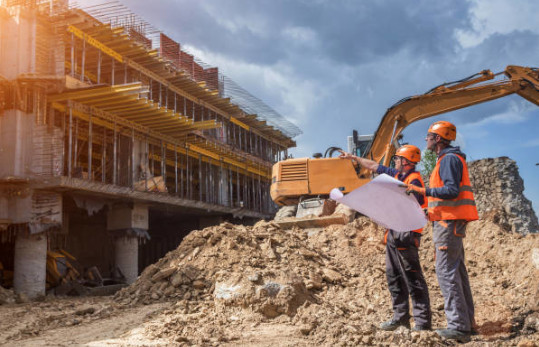Exactly How Consulting Engineers Enhance Geotechnical Design Projects: Insights Into Their Competence, Methods, and Collaborative Approaches
Consulting engineers are pivotal in boosting geotechnical engineering jobs, using their specialized knowledge to navigate the intricacies of subsurface problems. Their collaborative strategies foster communication amongst varied project stakeholders, eventually forming the project's trajectory.
Role of Consulting Engineers
The experience of speaking with designers in geotechnical design is basic to the effective execution of building tasks. These specialists play a pivotal function in examining soil and rock homes, which are important variables affecting design and construction decisions. By conducting extensive website examinations, getting in touch with designers accumulate important data that informs the design process, guaranteeing jobs are improved steady and suitable ground.
Consulting engineers also offer indispensable insights into risk management (geotechnical geologist). They recognize possible geotechnical threats, such as landslides, dirt liquefaction, and settlement problems, allowing stakeholders to carry out efficient mitigation strategies. Their proficiency aids in maximizing foundation layouts, which can result in considerable price savings and enhanced safety and security
Moreover, consulting designers function as an essential link in between job owners, engineers, and service providers. Their capacity to equate complex geotechnical information right into actionable referrals promotes cooperation and facilitates informed decision-making throughout the job lifecycle. This multidisciplinary technique not only enhances task performance but additionally makes sure compliance with governing requirements and ideal methods.
Key Techniques in Geotechnical Engineering

One primary method is website examination, which entails carrying out area tests and laboratory analyses to gather data on subsurface conditions. Methods such as Standard Penetration Screening (SPT) and Cone Infiltration Screening (CPT) are commonly made use of to review dirt stratigraphy and strength. In addition, geophysical approaches, including seismic and electrical resistivity surveys, provide non-invasive means to evaluate subsurface qualities.
Another crucial approach is numerical modeling, which enables designers to simulate numerous circumstances and forecast just how soil-structure communications will behave under various loading problems. Finite Element Analysis (FEA) is an usual strategy used in this context.
In addition, the layout of structures, keeping structures, and earthworks relies greatly on these methods - geotechnical geologist. By integrating sophisticated analytical tools with area information, seeking advice from engineers can develop customized remedies that attend to particular project obstacles, inevitably adding to the stability and safety and security of building and construction jobs
Significance of Soil Evaluation
Soil evaluation works as a foundational aspect in geotechnical engineering, supplying important understandings into the physical and chemical residential or commercial properties of dirt required for reliable construction preparation. Understanding soil qualities is vital for determining its load-bearing capability, water drainage behavior, and possibility for settlement or instability. In-depth dirt investigations, consisting of tasting and laboratory testing, aid identify specifications such as dirt kind, moisture material, thickness, and shear toughness.
These analyses notify the option of appropriate building methods and products, ultimately influencing job safety and security and longevity. Cohesive soils may need various structure styles contrasted to granular dirts, demanding customized design options. Soil analysis help in recognizing impurities that can posture threats to human wellness or the setting, enabling for the advancement of mitigation techniques.
Incorporating soil evaluation right into the beginning of project development aids to decrease unpredicted obstacles, making sure that engineers can anticipate and address possible problems before they escalate. By developing a thorough understanding of the website conditions, speaking with engineers can maximize style efficiency and reduce prices, consequently improving the overall success of geotechnical design jobs.
Collaborative Approaches in Jobs
Successful geotechnical tasks commonly hinge on collaborative strategies that combine varied expertise from numerous techniques. Reliable cooperation amongst seeking advice from engineers, rock hounds, ecological scientists, and building and construction professionals is crucial for attending to complex obstacles and optimizing task outcomes. By leveraging the special skills and understanding of each employee, tasks can benefit from an all natural understanding of the site problems, governing demands, and design constraints.
Routine interaction and interdisciplinary meetings assist in the sharing of understandings advice and foster a society of synergy. These collective initiatives make it possible for the identification of prospective threats early in the project lifecycle, enabling for prompt reduction techniques. Additionally, incorporating comments from stakeholders, including regional areas and regulatory agencies, makes sure that all viewpoints are considered, improving job approval and conformity.
Furthermore, the combination of innovative modern technologies, such as Geographic Details Equipment (GIS) and Structure Details Modeling (BIM), more boosts cooperation. These devices enable the real-time sharing of information and visualization of geotechnical problems, advertising educated decision-making. Inevitably, a joint strategy not just simplifies task implementation yet likewise lays the foundation for ingenious services to complicated geotechnical engineering challenges.
Effect On Project End Results

Consulting engineers employ sophisticated approaches such as risk evaluation and predictive modeling, which improve the precision of job projections. Their ability to incorporate innovative modern technologies, like geotechnical instrumentation and data analytics, additionally improves the style and building and construction processes. As a result, tasks experience improved effectiveness, lowered costs, and lessened hold-ups.
Moreover, promoting efficient interaction and collaboration among group participants improves problem-solving capacities. When challenges occur, a joined front allows for swift identification of options, avoiding possible setbacks. Ultimately, the collective initiatives of consulting engineers add to higher quality results, guaranteeing that projects meet both governing requirements and client expectations.
Final Thought
